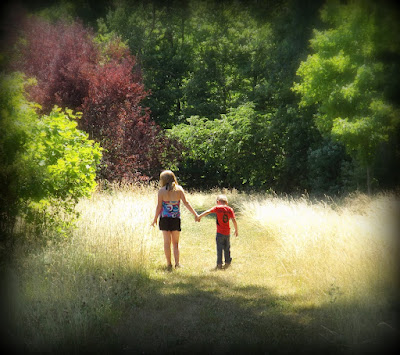Mengerson Nature Reserve is located in the heart of Fort Wayne, Indiana. In fact, we made a pit stop at Target right before we pulled in! As we were parking, it struck me how odd it was to be at a nature preserve in the middle of the city. But what a treasure for folks who live in town, to have a bit of Indiana's natural splendor so accessible!
 |
| "Which way to go?" |
As we entered the preserve (once we decided which path to take), it was like entering another world...one not situated in a town at all. Surrounded by the leafy trees, the active wildlife, and the calls of the birds, it was easy to forget where the preserve is located and get lost in nature's splendor.
 |
| The Mengerson Reserve was a gift of Carl and Ursula Mengerson, given in 1973. |
 |
| Carl Mengerson's Tree is an oak. |
The further we hiked, the more surprised I became at what a wonderful bit of forest is hiding right here in the city, from open meadow, to an area of early-stage woods, to a mature sugar maple forest!
 |
However, nothing surprised me more than when we stumbled upon her... |
 |
| We finally found our deer! Who knew it would be in a city preserve?! |
The kids actually saw her first. We've been looking for deer, any animals really, on all of our hikes and the first one we find is in the middle of town. How ironic. We went on to see a 'possum and several rabbits in the Mengerson Reserve.
 |
| The Mengerson Reserve is 36 acres with about a mile of trails. |
 |
| Ursula Mengerson's tree is a tulip. |
Not only did we have the opportunity to see and hear much wildlife today, but the kids and I saw many other interesting sights as well.
 |
| The proverbial "hollow log" |
 |
| Long, peeling strips of bark on the Shagbark Hickory |
 |
| European nightshade |
 |
| Wormy paths carved by critters dining underneath the bark of an ash tree. |
Unbeknownst to the children, (who would have rolled their eyes had I said, "look at those neat branches") my eye caught these images. Just branches and lines? Perhaps. But when I see them, my mind recalls images of some of my favorite stained glass artists.
 |
Sleeping Christ, by Harry Clarke
Chapel of the Sacred Heart
Diseart Institute of Education and Celtic Culture |
The time is drawing near for me to begin working on my own stained glass images inspired by my walks with Indiana's nature. I have many ideas bumping around in my head, but I also have a few more nature preserves to visit first. See you at the next one!




















































